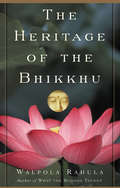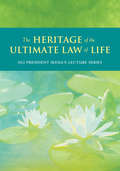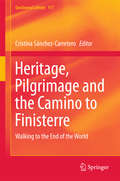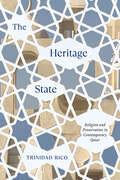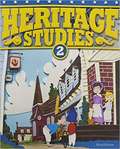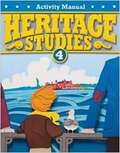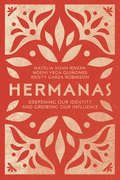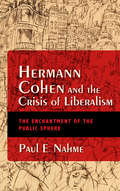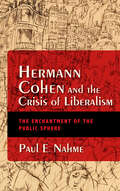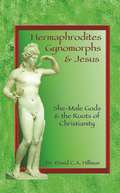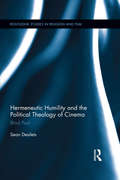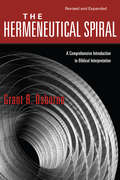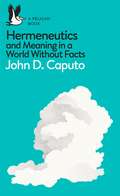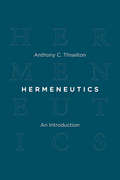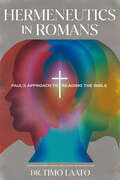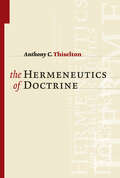- Table View
- List View
The Heritage of the Bhikkhu: The Buddhist Tradition of Service
by Walpola RahulaWalpola Rahula's What the Buddha Taught is a perennial backlist bestseller and has proven to be an indispensable guide to beginning Buddhism. It is renowned for its authoritative, clear, logical, and comprehensive approach. The Heritage of the Bhikkhu is a vivid account of the Buddhist's monk's role as a servant to people's needs as a follower and teacher of the basic Buddhist principles. In this fascinating and informative volume, the author emphasizes Buddhism as a practical doctrine for daily living and spiritual perfection and not simply a monastic discipline. The Heritage of the Bhikkhu is a pioneering work that deserves to stand with the author's earlier masterpiece.
The Heritage of the Ultimate Law of Life: Commentaries on the Writings of Nichiren (SGI President Ikeda's Lecture Series)
by Daisaku IkedaWhere have we come from and where do we go? Why are human beings born? Are our lives just random events or do they have some greater purpose? What is the meaning of death? Nichiren Buddhism, based on the Lotus Sutra, is a teaching of hope that provides answers to these and other important questions for modern life. Ranked among the most important works in Mahayana Buddhism, Nichiren’s 13th century writings were revolutionary. They sought to give people a deep sense of confidence and self-reliance in this lifetime by exploring the topics of death and eternal life. In his "The Heritage of the Ultimate Law of Life," Nichiren explains the ultimate Buddhist view, which frees people from both their fear of death and their unhealthy attachment to self. Daisaku Ikeda’s simple and straightforward commentary brings alive this important writing for the modern world. Thoughtful people of all faiths will resonate with his compassionate insights on the universal teaching of happiness that is Nichiren Buddhism.
The Heritage of the Ultimate Law of Life: Commentaries on the Writings of Nichiren (SGI President Ikeda's Lecture Series)
by Daisaku IkedaWhere have we come from and where do we go? Why are human beings born? Are our lives just random events or do they have some greater purpose? What is the meaning of death? Nichiren Buddhism, based on the Lotus Sutra, is a teaching of hope that provides answers to these and other important questions for modern life. Ranked among the most important works in Mahayana Buddhism, Nichiren’s 13th-century writings were revolutionary. They sought to give people a deep sense of confidence and self-reliance in this lifetime by exploring the topics of death and eternal life. In his The Heritage of the Ultimate Law of Life, Nichiren explains the ultimate Buddhist view, which frees people from both their fear of death and their unhealthy attachment to self. Daisaku Ikeda’s simple and straightforward commentary brings alive this important writing for the modern world. Thoughtful people of all faiths will resonate with his compassionate insights on the universal teaching of happiness that is Nichiren Buddhism.
Heritage, Pilgrimage and the Camino to Finisterre
by Cristina Sánchez-CarreteroThis book presents research concerning the effects of the Camino to Finisterre on the daily lives of the populations who live along the route, and the heritagization processes that exploitation of the Camino for tourism purposes involves. Rather than focusing on the route to Santiago de Compostela and the pilgrimage itself, it instead examines a peculiar part of the route, the Camino to Finisterre, employing multiple perspectives that consider the processes of heritagization, the effects of the pilgrimage on local communities, and the motivations of the pilgrims. The book is based on a three-year research project and is the result of a multidisciplinary collaboration between anthropologists, sociologists, historians and archaeologists. Instead of ending in Santiago, as the rest of the Caminos do, this route continues to the cape of Finisterre on the Galician Atlantic coast. This part of the Camino de Santiago is not officially recognized by the Catholic Church and does not count as part of reaching Compostela, the recognition granted by the Catholic Church to those pilgrims who have walked at least 100 km. For this reason, as well as its relationship with the sun cult, many pilgrims call this route "the Camino of the atheists. " In fact, the Catholic Church is a strong force for the heritagization of the rest of the Caminos, and maintains a clear ignoratio strategy concerning the Finisterre route: Officially, the church neither opposes nor recognizes this route.
The Heritage State: Religion and Preservation in Contemporary Qatar
by Trinidad RicoThe Heritage State examines the emergence and growth of a tradition of heritage and its preservation in the Arabian Peninsula following decades of the region's marginalization in global heritage debates, largely due to a Eurocentric worldview that prioritizes secular over religious ideas of heritage value and its circulation. Through an exploration of the rise of a powerful advocate for global and local heritage at the turn of the century in the State of Qatar, this book describes the possibilities for thinking about and acting on a heritage that expertly negotiates secular and religious contexts and purposes. Trinidad Rico invites a postcolonial examination of heritage traditions in the Middle East beyond the lens of iconoclasm and terrorism to shed light on and celebrate the ingenuity and hybridity involved in growing a culture of heritage. She describes how representation of agency and decision-making in the Middle East and Arabian Peninsula are still dominated by the theme of conflict and terrorism and, further, how cultural heritage debates are deeply implicated in this misrepresentation.It is critical to the future of cultural studies to demonstrate empirically, through historical records and contemporary practices, the extent to which these regions have been represented unfairly and excluded from developing more sophisticated identities and authorities in the emergence of global heritage. The Heritage State puts Qatar at the center of such a conversation, suggesting that Qatar is not a place where things happen but a place that makes things happen in the cultural sphere.
Heritage Studies 2
by Bju PressThis book is an easy-to-read presentation of social studies that integrates civics, culture, economics, geography, and history.
Heritage Studies 3 Third Edition
by Brian C. CollinsHeritage Studies 3 includes an age-appropriate study of civics and government and evaluates historical events in United States history from the Constitutional Convention through the Civil War, all from a Christian world view.
Heritage Studies 4: Student Activity Manual
by Bju PressHeritage Studies 4 Student Activities Manual, 3rd ed., provides full-colored pages that reinforce and enrich the lessons. Activities include graphic organizers, reinforcement pages, map skills, study skills, Bible connections, study guides, and chapter reviews. Primary Source documents are also included for some of the chapters.
Heritage Studies 4, Third Edition
by Bju PressHeritage Studies 4, 3rd ed., is a colorful, age-appropriate presentation of social studies that integrates government, culture, economics, and geography, all presented from a Christian worldview.
Heritage Studies 5 (3rd Edition)
by Peggy S. Alier James R. Davis Annittia Jackson Lori Weir Debra WhiteHistory and geography both help us understand the world around us. History is the study of the past. Geography is the study of place. Geography helps us learn not only where places are but also how they differ and why.
Heritage Studies 5, Fourth Edition
by Eileen Berry Ethan Birney Brian C. Collins Annittia JacksonBJU Press Heritage Studies 5 presents the narrative of American history from the creation of the car in the late 1800s through the 2015 Clean Power plan. Photographs, illustrations, maps, timelines, and notes highlight themes of geography, American history, government, economics, world history, and culture. Topics are presented from a biblical perspective and include the invention and influence of the automobile and airplane, World War I, the Roaring Twenties, the Great Depression, World War II, the Vietnam War, struggles over civil rights, the war on terror, Afghanistan and Iraq wars, and immigration decisions, all from a Christian worldview. This study highlights the role of significant Christians in American history and their viewpoints on historical events. This resource is also known as Bob Jones Heritage Studies Grade 5 Text, 4th Edition.
Heritage Studies 6 Activity Manual (3rd Edition)
by Peggy S. Alier Marnie Batterman Eileen M. Berry Ann L. Carruthers James R. Davis Annittia Jackson Laurie Tebbenkamp Debra White Dennae WhiteThe American Republic provides students with a survey of the history and heritage of the United States from Christian worldview.
Heritage Studies Student Grade 1, Third Edition
by Eileen Berry Gina Bradstreet Ann Larson L. Michelle RosierThe book examines the events from pre-1000 to 1682, covering Columbus, Plymouth, trading, Native Americans and other colonial events through the lens of God's redemptive plan.
Hermanas: Deepening Our Identity and Growing Our Influence
by Natalia Kohn Rivera Noemi Vega Quiñones Kristy Garza RobinsonGod calls Latinas to lives of influence. He created his Latina daughters to partner with him, live into the incredible plans he has for each of us, and walk in his grace and strength to help change this world. But many of us have heard cultural messages that make us doubt our adequacy. We have not seen many Latina women in positions of leadership, and we need more mentors and role models. Natalia Kohn, Noemi Vega Quiñones, and Kristy Garza Robinson share their own journeys as Latinas and leaders. They find mentorship in twelve inspirational women of the Bible including Esther, Rahab, Mary, and Lydia, who navigated challenges of brokenness and suffering, being bicultural, and crossing borders. As we deepen our spiritual and ethnic identities, we grow in intimacy with God and others and become better equipped to influence others for the kingdom. The insights here will help any who seek to empower Latinas in leadership. You are not alone on this journey. Join your sisters and partner with our heavenly Father as you become the Latina leader God has called you to be.
Hermann Cohen and the Crisis of Liberalism: The Enchantment of the Public Sphere (New Jewish Philosophy and Thought)
by Paul E. NahmeHermann Cohen (1842–1918) is often held to be one of the most important Jewish philosophers of the nineteenth century. Paul E. Nahme, in this new consideration of Cohen, liberalism, and religion, emphasizes the idea of enchantment, or the faith in and commitment to ideas, reason, and critique—the animating spirits that move society forward. Nahme views Cohen through the lenses of the crises of Imperial Germany—the rise of antisemitism, nationalism, and secularization—to come to a greater understanding of liberalism, its Protestant and Jewish roots, and the spirits of modernity and tradition that form its foundation. Nahme’s philosophical and historical retelling of the story of Cohen and his spiritual investment in liberal theology present a strong argument for religious pluralism and public reason in a world rife with populism, identity politics, and conspiracy theories.
Hermann Cohen and the Crisis of Liberalism: The Enchantment of the Public Sphere (New Jewish Philosophy and Thought)
by Paul E. NahmeA fresh look at a nineteenth-century Jewish philosopher whose theology offers a beacon in an illiberal twenty-first century world: “Recommended.” —ChoiceHermann Cohen is often held to be one of the most important Jewish philosophers of the nineteenth century. Paul E. Nahme, in this new consideration of Cohen, liberalism, and religion, emphasizes the idea of enchantment, or the faith in and commitment to ideas, reason, and critique—the animating spirits that move society forward.Nahme views Cohen through the lenses of the crises of Imperial Germany—the rise of antisemitism, nationalism, and secularization—to come to a greater understanding of liberalism, its Protestant and Jewish roots, and the spirits of modernity and tradition that form its foundation. Nahme’s philosophical and historical retelling of the story of Cohen and his spiritual investment in liberal theology present a strong argument for religious pluralism and public reason in a world rife with populism, identity politics, and conspiracy theories.
Hermaphrodites, Gynomorphs and Jesus
by David C. HillmanThe first western god was both male and female. All of western religion springs from the veneration of a bi-gender entity, known to the ancient world as the Gynomorph. The worship of hermaphroditic gods like the Gynomorph surfaces in ancient pagan cults as well as early Christianity.The celebration of female gods with penises impacted the development of western culture. Veneration of the Gynomorph is the basis for modern western law courts. The founders of democracy worshipped similar female divinities who possessed penises. Ritual sodomy as a means of celebrating hermaphroditic gods directly promoted the birth of western democracy. In fact, ancient priestesses responsible for guiding the worship of hermaphroditic goddesses laid the very foundations for democracy, science and philosophy.The oldest western pharmaceuticals were sex drugs used in religious initiations in celebration of the Gynomorph. Snake venoms used in cultic sex rituals were immensely popular in both Greece and Rome. In addition, abortion-inducing drugs promoted the first scientific investigations. Classical civilization relied heavily upon the use of cannabis, opiates, and hallucinogens, which were mixed with sexual stimulants. Greco-Roman witches, who served a prominent hermaphroditic goddess, Hecate, were among the earliest western scientists and naturalists.Devotees of gynomorphic divinities were the first westerners to promote the religious practice known as necromancy. The first "baptists" were cross-dressing necromancers, who celebrated the Gynomorph. Eunuchs who served the same goddess were chemically castrated with scorpion venom. Ancient pre-Christian oracles declared that the messiah must be a hermaphrodite. Christianity tried to assimilate and employ the use of necromancy. The earliest Christians used designer sex drugs in their rituals in order to venerate a messiah given gynomorphic status by church bishops.
Hermeneutic Humility and the Political Theology of Cinema: Blind Paul (Routledge Studies in Religion and Film)
by Sean DesiletsThis book revisits the tradition of Western religious cinema in light of scholarship on St. Paul’s political theology. The book’s subtitle derives from the account in the Book of Acts that St. Paul was temporarily blinded in the wake of his conversion on the road to Damascus. In imitation of Paul, the films on which Sean Desilets’s analysis hinges (including those of Carl-Th. Dreyer, Robert Bresson, Pier Paolo Pasolini, and Carlos Reygadas) place a god-blind mechanism, the camera, between themselves and the divine. Desilets calls the posture they adopt "hermeneutic humility": hermeneutic in that it interprets the world, but humble in that it pays particular—even obsessive—attention to its own limits. Though these films may not consciously reflect Pauline theology, Desilets argues that they participate in a messianic-hermeneutic tradition that runs from Paul through St. Augustine, Blaise Pascal, Karl Barth, and Walter Benjamin, and which contributes significantly to contemporary discussions in poststructuralist literary theory, political theology, and religious studies. Desilets’s insightful explication of Jean-Luc Nancy’s deconstruction of Christianity and Georgio Agamben’s recent work on religion makes a substantial contribution to film philosophy and emerging critical trends in the study of religion and film. This book puts forward a nuanced theoretical framework that will be useful for film scholars, students of contemporary political theology, and scholars interested in the intersections of religion and media.
The Hermeneutical Spiral: A Comprehensive Introduction to Biblical Interpretation
by Grant R. OsborneChristianity TodayIn this newly revised and expanded edition, Grant Osborne provides seminary students and working pastors with the full set of tools they need to move from sound exegesis to the development of biblical and systematic theologies and to the preparation of sound, biblical sermons.Osborne contends that hermeneutics is a spiral from text to context--a movement between the horizon of the text and the horizon of the reader that spirals nearer and nearer toward the intended meaning of the text and its significance for today.The Hermeneutical SpiralChristianity Today
Hermeneutics: Facts and Interpretation in the Age of Information (Pelican Books)
by John D. CaputoIs anything ever not an interpretation? Does interpretation go all the way down? Is there such a thing as a pure fact that is interpretation-free? If not, how are we supposed to know what to think and do? These tantalizing questions are tackled by renowned American thinker John D Caputo in this wide-reaching exploration of what the traditional term 'hermeneutics' can mean in a postmodern, twenty-first century world. As a contemporary of Derrida's and longstanding champion of rethinking the disciplines of theology and philosophy, for decades Caputo has been forming alliances across disciplines and drawing in readers with his compelling approach to what he calls "radical hermeneutics." In this new introduction, drawing upon a range of thinkers from Heidegger to the Parisian "1968ers" and beyond, he raises a series of probing questions about the challenges of life in the postmodern and maybe soon to be 'post-human' world.'
Hermeneutics: An Introduction (Scripture And Hermeneutics Ser. #No. 5)
by Anthony C. ThiseltonAnthony Thiselton here brings together his encyclopedic knowledge of hermeneutics and his nearly four decades of teaching on the subject to provide a splendid interdisciplinary textbook. After a thorough historical overview of hermeneutics, Thiselton moves into modern times with extensive analysis of scholarship from the mid-twentieth century, including liberation and feminist theologies, reader-response and reception theory, and postmodernism. No other text on hermeneutics covers the range of writers and subjects discussed in Thiselton’s Hermeneutics.
Hermeneutics: An Introduction (Scripture And Hermeneutics Ser.)
by Anthony C. ThiseltonAnthony Thiselton here brings together his encyclopedic knowledge of hermeneutics and his nearly four decades of teaching on the subject to provide a splendid interdisciplinary textbook. After a thorough historical overview of hermeneutics, Thiselton moves into modern times with extensive analysis of scholarship from the mid-twentieth century, including liberation and feminist theologies, reader-response and reception theory, and postmodernism. No other text on hermeneutics covers the range of writers and subjects discussed in Thiselton’s Hermeneutics.
Hermeneutics in Romans: Paul's Approach to Reading the Bible
by Timo Laato Bror Erickson Kristina Odom Weslie Odom"And behold, a lawyer stood up to put him to the test, saying, "Teacher, what shall I do to inherit eternal life?" He said to him, "What is written in the Law? How do you read it?" (Luke 10:25-26)Eternal life is found within the pages of Holy Scripture, both in the Old Testament Torah referred to as "the Law" in this exchange between Jesus and the lawyer, and in the New Testament written in the wake of Christ's resurrection. But as Jesus points out, it matters how you read Holy Scripture, and this is where the art of hermeneutics, the study of interpretation, makes its entrance. In Hermeneutics in Romans, Dr. Timo Laato returns to the old Lutheran maxim that scripture interprets scripture. Usually this maxim meant that portions of scripture that were clear should be used to shed light on portions of scripture that are unclear. Dr. Laato takes it even one step further. He turns to Romans to study the hermeneutical principles that Paul used to interpret the Old Testament in that epistle. This results in a dynamic view of the Bible, rescuing hermeneutics from the dead atheistic presumptions that have governed academic hermeneutical research since Kant. Not only does Dr. Laato's approach make immanent sense on the face of it, it breathes life into the study of scripture and delivers eternal life to the reader in Jesus Christ who proves to be the ultimate hermeneutical key.
The Hermeneutics of Christological Psalmody in Paul
by Matthew ScottBy reexamining the quotation of psalms in Paul, this book offers a fresh interpretation of the New Testament's reception of the Old Testament. Richard Hays's influential Echoes of Scripture in the Letters of Paul astutely identified the rhetorical device of metalepsis, or echo, as central to the study of Pauline hermeneutics. Hays's Paul was in sympathetic dialogue with the voice of Scripture, but Matthew Scott now challenges this assumption with close readings of echoed psalms voiced by David and Christ. Paul's use of metalepsis in Romans and 2 Corinthians reveals him to be a provocative, even polemical, reader who appropriates the words of David for a Christological purpose. Scott also illustrates how Christ succeeds David as the premier psalmist in Paul and considers whether, in doing so, Christ acts as inheritor or iconoclast.
The Hermeneutics of Doctrine
by Anthony C. ThiseltonDrawing on the resources of contemporary hermeneutical theory, Anthony Thiselton in this volume masterfully recovers the formative and transformative power of Christian doctrine.The past thirty-five years have witnessed major steps forward in the use of hermeneutics in biblical studies, but never before has hermeneutics made a comparable impact on the formulation of doctrine and our engagement with it. Indeed, no other book explores the interface between hermeneutics and Christian doctrine in the same in-depth way that this one does. Throughout the book Thiselton shows how perspectives that arise from hermeneutics shed fresh light on theological method, reshape horizons of understanding, and reveal the relevance of doctrine for formation and for life.Arguably the leading authority worldwide on biblical and philosophical hermeneutics, Thiselton has written widely acclaimed works in the areas of biblical studies and philosophical theology. His probing interaction in The Hermeneutics of Doctrine with numerous other great thinkers -- Gadamer, Ricoeur, Lindbeck, Balthasar, Vanhoozer, Pannenberg, etc. -- and his original perspectives will make this volume a valuable resource for scholars and advanced students.
